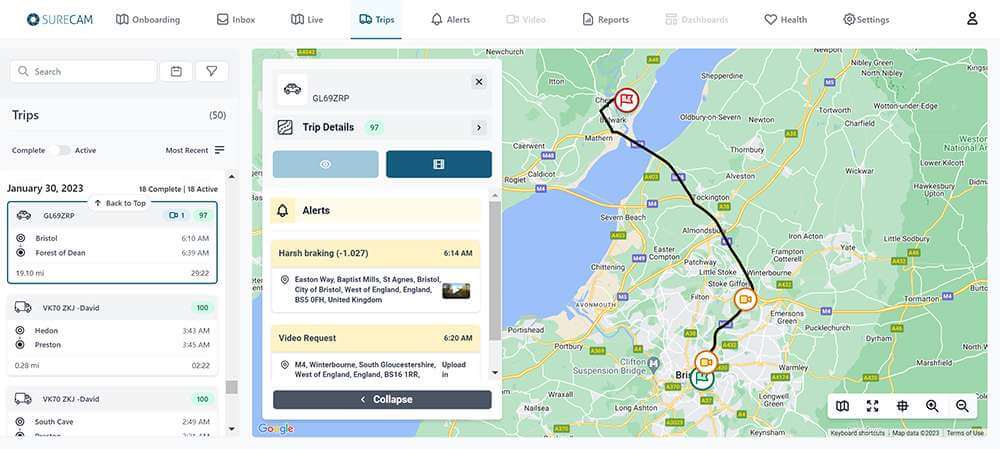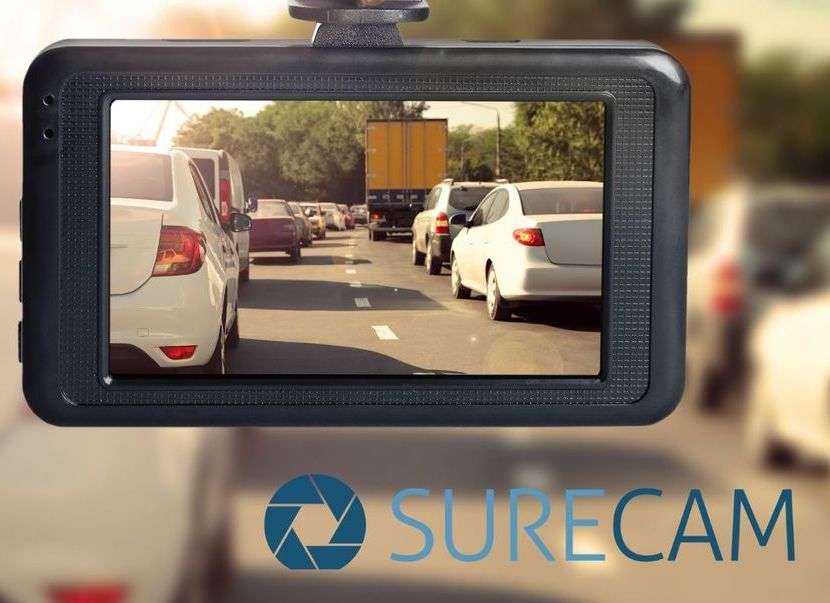Fleet Dash Cam Guide: Boost Efficiency & Safety

Buyer's Guide
Are you a business owner or operations manager looking for the best solution to manage your fleet operations? Do you know what dash cams are and how they can help you optimize your fleet? With ever-increasing traffic and safety concerns, investing in fleet dash cams is becoming even more popular among businesses. Dash cams provide real-time data and insights on trip activities, leading to improved safety performance, operational efficiencies, time savings, and cost reduction.
If you've been considering investing in a fleet dash cam but aren't sure how to go about it, this buyer’s guide is for you. We’ll help you understand what fleet dash cams are, as well as their cost, types, features, and associated benefits.
What Are Fleet Dash Cams?
Fleet dash cams are cameras installed on the dashboard of a vehicle. They record external video footage with road-facing cameras as the vehicle moves, such as road conditions and traffic movement. They also record internal footage with driver-facing cameras. Dash cams provide fleets with an extra layer of security, road safety, and accountability by detecting road incidents, tracking driver practices, and identifying potential risks before they cause an accident.
SureCam dash cameras have both video and GPS tracking capabilities (video telematics). This enhances fleet safety and can be used as evidence for accident claims. Leveraging video telematics can give safety managers and fleet owners data they can use for training, tracking, or — in the event of an incident — to prove who was at fault.
How Does a Fleet Dash Cam System Work?
It's essential to understand how a dash cam system works to choose the right one. A typical fleet dash cam system includes cameras and data storage hardware, an installation kit, and viewing software.
The fleet's electrical system often powers the dash cam system and is programmed to automatically turn on when the ignition is on. Once activated, the dash cameras start recording and storing data on the storage media. The storage media can be an internal SD card, USB drive, or stored in the cloud.
The data recorded on the storage media can be accessed in real-time or later through an app or website. This allows fleet managers to review dash cam footage, track driver activities, and identify potential risks, which can help them make informed decisions.
How Much Do Fleet Dash Cams Cost?
The cost of fleet dash cams depends on the size of your fleet, type of device, and features. For instance, a fleet size of 3 to 50 has a particular price per vehicle per month based on how much video is accessed, while larger fleet sizes may have customized plans.
On the other hand, a single-camera system is more affordable than a dual-camera system. The dual-camera system is more complex and requires additional hardware, data storage, and software. Additionally, wireless cams are more expensive than their wired counterparts due to the need for extra equipment like antennas and routers.
With that in mind, it's important to note that some dash cam solutions offer additional features like vehicle tracking, live streaming, remote access, and cloud storage, which may increase the price. Nonetheless, SureCam offers competitive prices for a range of fleet dash cams. Regardless of your budget, SureCam ensures you have various options for your dash cam solution. For instance, our monthly, annual, and 36-month pricing plans make it easy to choose the best option for your needs.
Should My Fleet Use Dash Cams?
The short answer is yes. Why? Because dash cams can help you get the most out of your fleet. Here are some of the main benefits of why your fleet should use connected dash cams:
- Reduce insurance claims: Dash cams can help protect your business and drivers from false claims by providing concrete video evidence in the case of an accident.
- Boost safety: They identify and help correct unsafe driving habits like speeding, texting, or tailgating.
- Improve visibility: Remote access to both video and GPS tracking data helps you keep track of your team at all times.
- Enforce seatbelt and mobile phone compliance: Dashboard cameras can hold drivers accountable for following safety regulations, like wearing a seatbelt or not using a mobile phone while driving. It increases safety for both the driver and others on the road.
- Reduce vehicle maintenance costs: Alerts for high speed and harsh braking help you keep wear and tear of vehicles at a minimum.
Types of Fleet Dash Cams
Before buying or installing fleet dash cameras, you must first understand what types of dash cams are available and which is right for your fleet. Here are the most common types of dash cams used by fleets:
SD Dash Cameras
SD dash cameras are a type of dash cam commonly used in small fleets. They store dash cam footage on an SD card and do not have wireless connectivity for upload or live streaming. They're a great option for fleets that want basic vehicle visibility at the lowest cost possible.
Connected Dash Cameras
These are the most advanced type of dash cams. They have cellular network connections and upload dash cam footage to the cloud for remote access. They provide instant access to telematics data, such as vehicle speed, idle time, location, and harsh braking and acceleration. These cameras can also alert managers to incidents such as collisions or crashes.
Forward-Facing View
The forward-facing dash cams provide a wide-angle view of the road ahead. These front-facing connected cameras offer privacy to drivers, as they are road-facing only. Since they are GPS-enabled, they record the vehicle’s position and provide instant notifications whenever an incident occurs.
Dual-View
Unlike the forward-facing view camera, dual-view cameras have dual lenses that capture footage from inside and outside the vehicle. It allows complete visibility of unsafe driving habits, such as distracted or aggressive driving. You can use a dual dash cam to monitor the road and the driver or cargo in real time.
Exterior-Mounted View
Exterior-mounted view cameras are perfect for fleets, providing front and exterior rear views. These rear cameras provide visibility into potential blindspots and are often used to monitor cargo and equipment being transported behind the vehicle.
Features of SureCam Fleet Dash Cams
As mentioned, dash cams have various features that make them an ideal investment for any fleet. Here are some of the features of SureCam's fleet dash cam solutions:
- GPS tracking: SureCam lets you know where your vehicles are and ensures driver compliance with designated routes.
- Live-streaming: Remotely tap into a vehicle’s dash camera video in real-time for greater visibility, convenience, and control.
- Safety scores: Improve driver safety with quick insights into unsafe driving behaviors and other incidents.
- Speeding data: Monitor vehicle speed in real-time and stay within the legal speed limits.
- Cloud connectivity: Connects to SureCam’s cloud-based platform for easy access to data.
- Trip history: Dash cams keep track of vehicle activity to allow you to easily view detailed performance logs of past trips.
- Instant alerts: Notify you of incidents so you can respond immediately.
- Geotab compatible: Our commercial dash cams integrate with Geotab’s telematics software to access fleet data.
- Night vision: Our dash cams’ HD video quality is clear both night and day.
How a Fleet Dash Cam System Elevates the Efficiency of and Safety of Your Fleet
A fleet dash cam system is a valuable tool that can greatly enhance the efficiency and safety of your fleet operations. With advanced camera technology and intelligent features, these systems provide numerous benefits for fleet managers and drivers alike. Let's explore how a fleet dash cam system can elevate the efficiency and safety of your fleet.
Accident Prevention and Driver Safety
One of the primary advantages of a fleet dash cam system is its ability to enhance driver safety and prevent accidents. Dash cams capture real-time footage of the road and driver behavior, allowing fleet managers to monitor driver performance and ensure compliance with safety regulations. The presence of a dash cam encourages drivers to be more cautious and responsible while on the road, reducing the likelihood of accidents and promoting safe driving practices.
Incident Documentation and Liability Protection
In the unfortunate event of an accident or incident, a fleet dash cam system serves as an objective witness, providing accurate and reliable documentation of the events leading up to and during the incident. This footage can be crucial in determining fault and liability, protecting your company's reputation, and resolving insurance claims efficiently. By having clear evidence, you can avoid false claims and reduce legal disputes, ultimately saving time and resources.
Efficient Fleet Management
The best dash cam system offers powerful tools for fleet management. Advanced features like GPS data, geofencing, and real-time monitoring enable fleet managers to have a comprehensive view of their fleet's activities. They can track vehicle locations, monitor driver behavior, and optimize routes to improve overall efficiency. By identifying areas for improvement and implementing necessary changes, fleet managers can enhance productivity, reduce fuel costs, and streamline operations.
Driver Performance and Training
Dash cam video provides valuable insights into driver behavior and performance. Fleet managers can view dash cam footage to assess driver skills, identify areas for improvement, and provide targeted training or coaching. This helps optimize driver performance, promote safe driving habits, avoid distracted driving, and reduce incidents caused by human error. By monitoring and training drivers effectively, fleet managers can minimize risks, maintain a high level of professionalism, and improve overall fleet efficiency.
Insurance Premium Reduction
Implementing a fleet dash cam system can potentially lead to reduced insurance premiums. Insurance providers often offer discounts or special rates for fleets equipped with dash cams due to the added safety and security benefits they provide. By actively investing in the safety of your fleet, you not only protect your drivers and assets but also save money in the long run.
A dash cam system offers numerous advantages that elevate both the efficiency and safety of your fleet operations. From accident prevention and incident documentation to efficient fleet management and driver performance monitoring, these systems provide comprehensive solutions for today's fleets. By implementing a fleet dash cam system, you can proactively address potential risks, optimize operations, and create a safer environment for your drivers, ultimately benefiting your business as a whole.
Scale Your Business With SureCam’s Fleet Camera System
SureCam's fleet dash camera system is the best your business can invest in to support your fleet. With our comprehensive solutions, you can ensure the safety of your fleet and optimize operations for better business results. Our dash cams' features can help ensure you have the visibility needed to maintain a safe driving environment, reduce accident insurance claims, and boost overall activity.
With SureCam, you can improve customer service and satisfaction, reduce costs, and optimize fleet performance. Ready to invest in the best dash cams for your fleet? Contact us today to scale your business with commercial vehicle cameras.

Book a demo today!
SureCam offers GPS vehicle tracking, live video, and real-time alerts for efficient fleet management. Get a Demo



